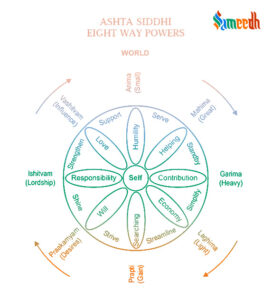“Ishitva” comes from the Sanskrit root “ish,” which means lord or ruler. “Siddhi” means accomplishment or attainment. Therefore, “Ishitva Siddhi” represents the ability to possess lordship or mastery over various aspects of existence.

“Ishitva Siddhi” refers to the attainment of lordship or mastery over things, and it is often considered one of the Siddhis or supernatural powers in Hinduism. Siddhis are spiritual or mystical abilities attained through rigorous spiritual practice, meditation, and the awakening of latent potentials within the individual.
In the context of Hindu spiritual traditions, “Ishitva Siddhi” may include the ability to control or command natural forces, manipulate elements, influence events, or possess dominion over other beings. This Siddhi is often associated with advanced stages of spiritual development and is considered a by-product of profound inner transformation and realization.
The attainment of “Ishitva Siddhi” is often viewed as a blessing or grace from the divine. It implies that the practitioner has earned the favor of the divine through devotion, discipline, and righteous living, leading to the manifestation of supernatural abilities. In Hindu philosophy, the universe is governed by a cosmic order (dharm) upheld by various deities and cosmic forces. “Ishitva Siddhi” signifies alignment with this cosmic order, allowing the practitioner to harmonize their will with the divine will and exert influence in accordance with higher spiritual principles.
Those who attain “Ishitva Siddhi” are expected to use their powers for the benefit of others and the greater good. They are called upon to serve as leaders, guides, and protectors, upholding righteousness (dharm) and guiding others on the path of spiritual evolution.
The journey towards attaining “Ishitva Siddhi” involves profound inner transformation and evolution. It requires overcoming egoic tendencies, transcending limitations, and realizing one’s divine nature. The attainment of this Siddhi signifies the culmination of this transformative process. With great power comes great responsibility. Practitioners who attain “Ishitva Siddhi” are expected to exercise their powers with wisdom, compassion, and integrity. They are accountable for their actions and must ensure that their use of Siddhis aligns with higher spiritual principles and serves the welfare of all beings.
In Hindu mythology and scriptures, there are several stories of individuals who have attained mastery or lordship over various aspects of existence, which could be interpreted as manifestations of “Ishitva Siddhi.” Here are a few notable examples:
- Lord Krushna: In Hindu tradition, Lord Krishna is revered as an incarnation of the Supreme Being (Vishnu). He displayed numerous extraordinary powers throughout his life, including lifting the Govardhan Hill to protect the villagers of Vrindavan from torrential rains, defeating powerful demons, and guiding the Pandavs to victory in the Mahabharat war. Krushna’s divine actions exemplify his mastery over the cosmic order and his role as a divine leader and protector.
- Lord Ram: Another incarnation of Vishnu, Lord Ram, demonstrated his mastery over various aspects of existence in the epic Ramayan. He single-handedly defeated the mighty demon king Ravan, built a bridge across the ocean with the help of an army of monkeys, and ruled Ayodhya with righteousness and compassion. Ram’s divine exploits and exemplary leadership illustrate his attainment of “Ishitva Siddhi.”
- Hanuman: Hanuman, the devoted disciple of Lord Ram and an embodiment of devotion and service, possessed extraordinary powers granted by various gods. He could change his size at will, fly through the air, and perform miraculous feats. Hanuman’s unwavering devotion to Ram and his selfless service to humanity exemplify the qualities of a true master and leader.
- Parashuram: Parashuram, the sixth avatar of Vishnu, was renowned for his martial prowess and mastery over weaponry. He is said to have conquered the entire world twenty-one times and purified it of the corrupt Kshatriya rulers. Parashuram’s legendary exploits demonstrate his mastery over the physical realm and his role as a divine enforcer of justice.
- Patanjali: Patanjali, the ancient sage and author of the Yoga Sutras, is revered as one of the greatest authorities on yoga and spiritual practices. He is said to have possessed extraordinary powers, including the ability to levitate and teleport. Patanjali’s teachings on yoga and meditation have guided countless seekers on the path to spiritual realization.
These are just a few examples of individuals from Hindu mythology and tradition who are believed to have attained mastery or lordship over various aspects of existence, which could be seen as manifestations of “Ishitva Siddhi.” Their stories serve as inspiration for spiritual aspirants and exemplify the potential for spiritual evolution and divine realization in the human experience.
It’s important to note that while Siddhis like “Ishitva Siddhi” are mentioned in various Hindu scriptures and texts, the emphasis in spiritual practice is typically placed on transcending attachment to such powers and progressing towards higher states of consciousness, self-realization, and spiritual liberation (moksh). Additionally, the ethical use of Siddhis for the benefit of others and in alignment with spiritual principles is emphasized in many spiritual traditions.
